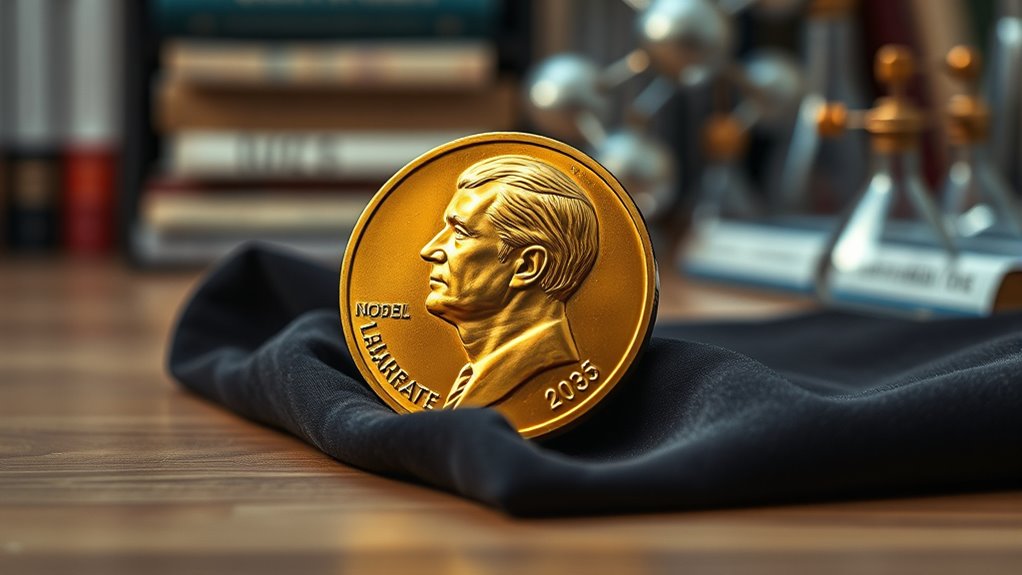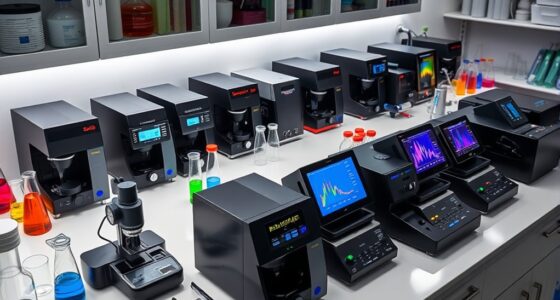The Nobel Prize in Chemistry has evolved from honoring mainly Western European and American scientists to recognizing global contributions across diverse fields like biochemistry, nanotechnology, and AI. Key milestones include discoveries such as fullerenes, DNA structure, and sustainable chemistry. Trends show increasing collaboration and recognition of interdisciplinary work. To discover how these developments shaped the science we celebrate today, explore the full history and breakthroughs behind this influential award.
Key Takeaways
- The Nobel Prize in Chemistry was established in 1901, evolving from recognizing mainly Western European and American scientists to a diverse, global selection.
- Early winners focused on organic chemistry and electrochemistry, with recent awards highlighting breakthroughs like genome editing and AI-driven structural biology.
- The award process involves international nominations, rigorous reviews, and increasingly recognizes collaborative, interdisciplinary, and team-based research efforts.
- Notable milestones include discoveries of fullerenes, advances in catalysis, and innovations in sustainable chemistry and materials science.
- The prize has recognized pioneering individuals like Marie Curie, Frederick Sanger, and Barry Sharpless, reflecting evolving scientific priorities and collaborations.
Origins and Establishment of the Nobel Prize in Chemistry

The Nobel Prize in Chemistry was established through Alfred Nobel’s last will, signed on November 27, 1895. You learn that Nobel dedicated most of his fortune—about 94%, roughly 31 million Swedish kronor—to fund these awards, aiming to honor those who bring the greatest benefit to mankind. The Nobel Foundation manages his estate and guarantees the awards follow his original intentions. The Royal Swedish Academy of Sciences is responsible for selecting the laureates. The first chemistry prize was awarded in 1901 to Jacobus Henricus van ’t Hoff for his work on chemical dynamics. Nobel’s will was approved by the Norwegian Parliament in 1897, and the foundation’s statutes were promulgated by King Oscar II in 1900, marking the start of a new era in recognizing scientific achievement globally. This process underscores the importance of scientific recognition in advancing knowledge and innovation worldwide, especially as it emphasizes the significance of scientific progress in shaping our future.
Evolution of Award Recipients and Laureates

As the Nobel Prize in Chemistry has evolved, so has the profile of its recipients. You’ve seen the first woman laureate, Marie Curie, honored in 1911, and more women like Frances Arnold recognized in recent decades, reflecting growing gender diversity. Additionally, the award’s recognition of groundbreaking work in projector technology highlights the expanding scope of scientific achievement. Early winners were mainly Western European or American men, but the 21st century shows increased awards to scientists from Asia, Latin America, and other regions. You’ll also notice a few repeat laureates, like Frederick Sanger and Barry Sharpless, who earned the prize twice for groundbreaking work. Collaboration has become more common, with team-based awards highlighting the interdisciplinary nature of modern research. Recognizing the importance of scientific collaboration, the Nobel committee has increasingly awarded teams rather than individuals. Moreover, the evolving scientific fields demonstrate the broadening impact of chemistry in addressing global challenges and technological advancements. Younger scientists are earning recognition earlier, and fields have expanded from classical chemistry to biochemistry, materials science, and applied research, illustrating the prize’s evolving scope.
Prominent Scientific Themes and Discoveries Over the Years
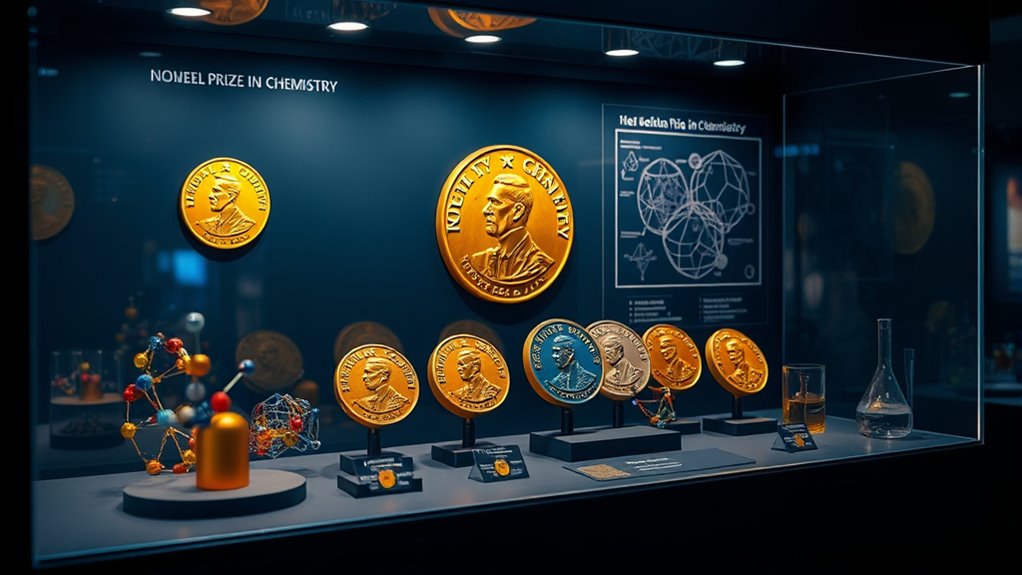
Over the years, Nobel Prizes in Chemistry have highlighted key scientific themes and groundbreaking discoveries that shape the field. About half of recent awards recognize new research methods, like genome editing, honored in 2020, and super-resolved microscopy, awarded in 2014. These innovations revolutionize molecular imaging and gene editing. Meditation practices are increasingly recognized for their role in enhancing mental clarity and focus, which can indirectly support scientific creativity and problem-solving. Advances in instrumentation have also played a crucial role in enabling these breakthroughs by allowing scientists to observe phenomena at unprecedented resolutions. The 2024 prize celebrates AI-based protein structure prediction, solving a 50-year-old puzzle. Discoveries of fullerenes, hollow carbon molecules, opened new areas in materials science, impacting superconductors and catalysts. Catalysis remains essential, with breakthroughs in asymmetric reactions and sustainable processes like photocatalysis. Advances in biochemistry, such as understanding DNA, RNA, and protein structures—particularly through AI—have driven progress in medicine and molecular biology. Additionally, understanding resources and tools available to scientists has significantly accelerated research and innovation. Physical chemistry and new materials, including carbon allotropes, continue to expand our understanding of matter and its properties.
Major Milestones by Decades
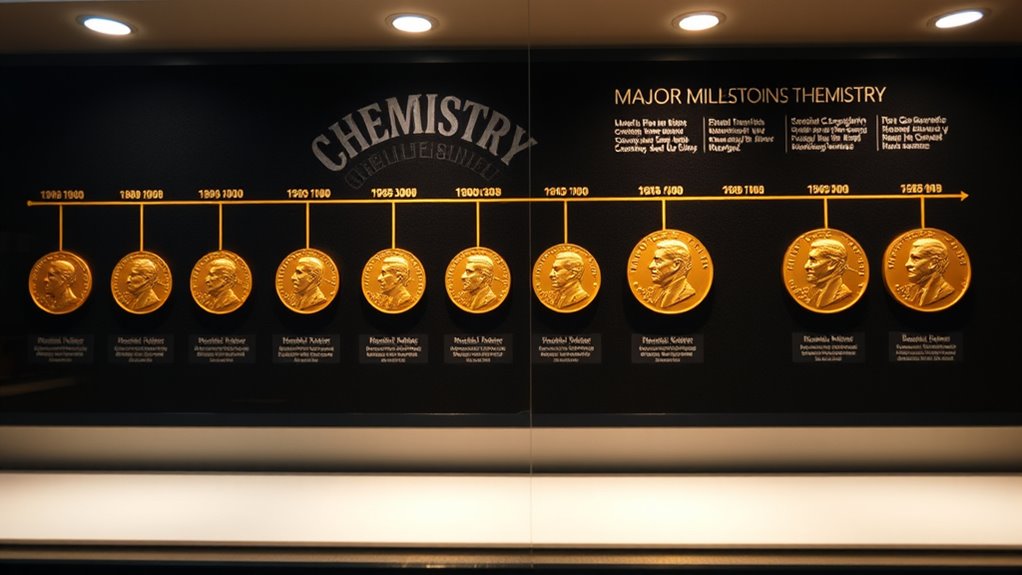
Since Nobel Prizes in Chemistry began in 1901, each decade has marked significant shifts and milestones that reflect the evolving landscape of the field. The early 1900s focused on foundational work in organic chemistry and electrochemistry, with Jacobus van ‘t Hoff earning the first prize for chemical dynamics. These early advances laid the groundwork for future innovations and interdisciplinary approaches.
The 1920s and 1930s expanded into biochemistry and physical chemistry, pioneering techniques like electrophoresis and spectroscopy. During this period, analytical methods became increasingly sophisticated, enabling scientists to explore complex biological molecules with greater precision.
Post-World War II, the 1940s and 1950s celebrated advances in molecular understanding, including quantum chemistry and structural analysis via X-ray crystallography. These breakthroughs revolutionized our understanding of molecular structures and reactions at an atomic level.
The 1960s and 1970s highlighted catalysis, polymer chemistry, and biochemical mechanisms, often embracing interdisciplinary research. The development of new synthetic pathways and materials during this era significantly impacted industrial applications and material sciences.
From the 1980s onward, milestones shifted towards computational chemistry, nanotechnology, and stereochemistry, reflecting rapid technological and conceptual progress in the field. Additionally, the integration of AI security technologies has begun to influence research methodologies and data analysis in modern chemical research, enhancing precision and collaboration.
Growth in Nomination and Selection Processes
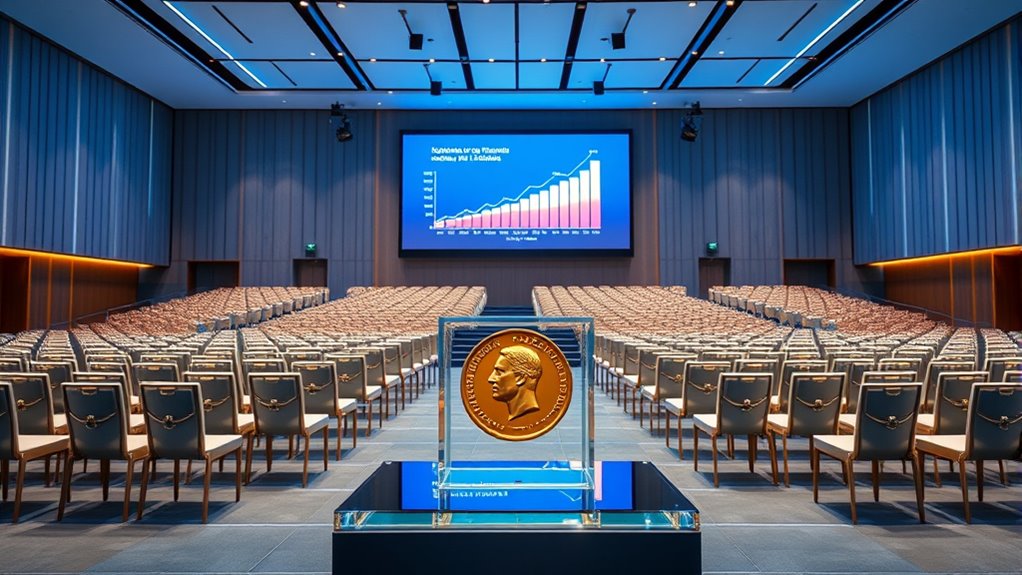
Have you ever wondered how the Nobel Prize in Chemistry selects its laureates? Each September, invitations are sent to thousands of distinguished university professors, scholars, members of the Royal Swedish Academy of Sciences, and past laureates worldwide.
Self-nominations aren’t allowed, maintaining the process’s integrity. Over time, the pool of potential nominators has grown, reflecting broader geographic and disciplinary diversity.
Nominations are due by January 31, with confidentiality rules protecting nominee identities. Between March and May, nominated candidates undergo rigorous review by external experts, whose assessments help the Nobel Committee shortlist finalists.
From June to August, the committee drafts a detailed recommendation report, debated and approved by the Academy in September. This structured process guarantees transparency, fairness, and the continuous evolution of the selection criteria.
Impact of the Prize on Scientific Research and Society

The Nobel Prize in Chemistry doesn’t just honor individual achievement; it actively shapes the scientific landscape and society at large. By recognizing innovative research methods like genome editing and AI-driven tools such as AlphaFold2, it accelerates scientific progress and inspires further innovation.
The award validates new techniques, encouraging collaboration and knowledge sharing across disciplines. These breakthroughs often lead to practical applications, from developing life-saving drugs to addressing environmental challenges, boosting economic growth and public health.
Additionally, the Nobel Prize raises awareness of chemistry’s essential role, inspiring future scientists and informing educational content. It fosters a collaborative, global research environment and motivates researchers to pursue groundbreaking discoveries that benefit society as a whole.
Recognition of Collaborative and Interdisciplinary Efforts
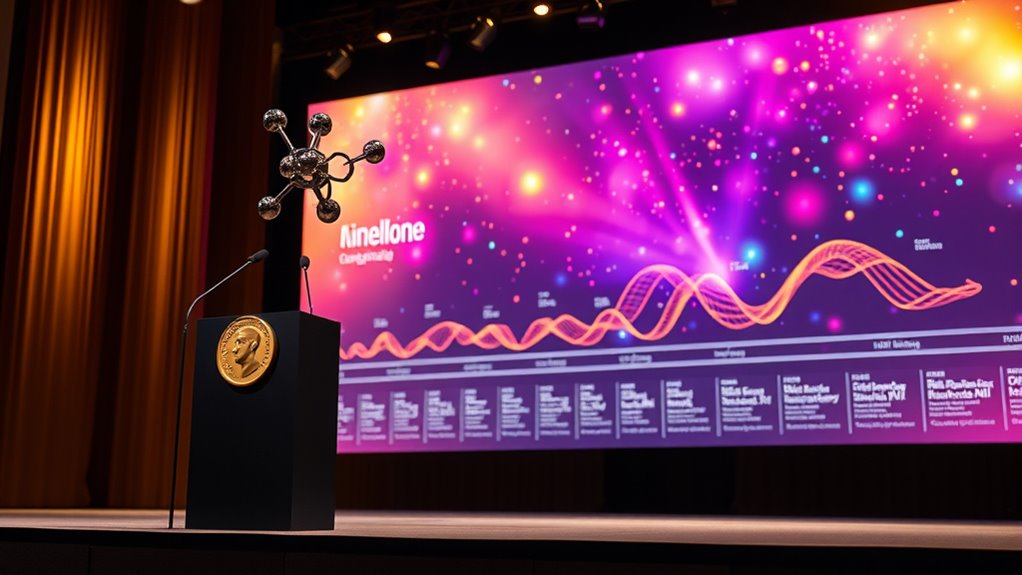
How has the Nobel Prize in Chemistry evolved to better recognize the collaborative nature of modern science? It increasingly honors teams rather than individuals, reflecting today’s research practices. You’ll see multiple laureates awarded jointly for work crossing disciplinary boundaries, like the 2021 prize for asymmetric organocatalysis, which involved both academic and industrial collaborators.
Interdisciplinary projects, such as Stanford’s Bio-X, support integrated research blending biology, chemistry, physics, and engineering—leading to Nobel-winning discoveries. The Nobel committees now explicitly acknowledge collaboration’s growing importance in solving complex problems.
Laureates often emerge from cross-sector partnerships, cross-lab networks, and international collaborations. As science becomes more interconnected, the prize’s criteria adapt, emphasizing team efforts and interdisciplinary approaches as essential to groundbreaking breakthroughs.
Recent Breakthroughs and Future Directions in Chemistry
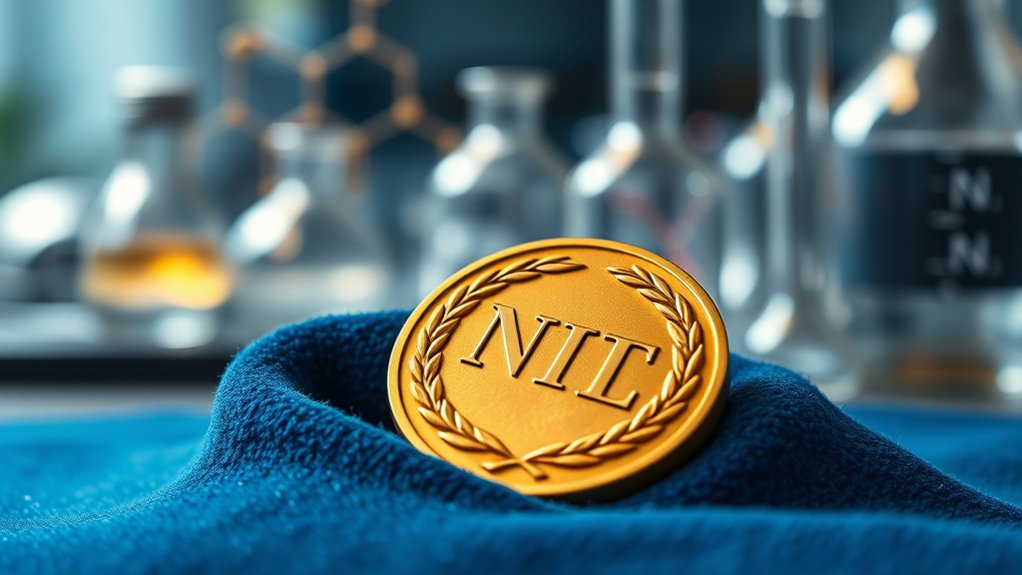
Advances in chemistry are shaping a sustainable and innovative future, building on the collaborative efforts that drive modern science. Recent breakthroughs include developing new materials with lower environmental impacts, such as sustainable syntheses and carbon capture rocks that absorb CO₂ rapidly and cheaply.
You’ll find innovations in molecular editing that streamline drug discovery, reduce waste, and cut costs, with applications extending to fertilizers and materials. Green chemistry techniques now eliminate chlorine from ethylene oxide, reduce steel’s carbon footprint, and convert CO₂ into fuel, aiding energy sustainability.
Additionally, technologies like sodium-ion and nuclear batteries improve energy storage, while observing electron motion enhances understanding of material properties. These advancements set the stage for a future where chemistry drives environmental solutions and technological progress.
The Role of Global Institutions and Researchers

Global institutions and researchers play a crucial role in shaping the landscape of chemistry by fostering collaboration, setting standards, and recognizing outstanding achievements.
The Royal Swedish Academy of Sciences awards the Nobel Prizes in Chemistry through a rigorous process involving nominations, expert consultations, and voting. Nominations come from qualified individuals worldwide, including university professors and previous laureates, with deadlines and strict confidentiality.
International researchers contribute to a diverse nomination pool, reflecting global scientific progress. Prestigious universities not only host advanced research but also provide nomination rights and facilitate collaborations that lead to groundbreaking discoveries.
This global participation ensures the Nobel Prize recognizes a broad range of contributions, inspiring future scientists and promoting international scientific cooperation.
Notable Double Laureates and Their Contributions
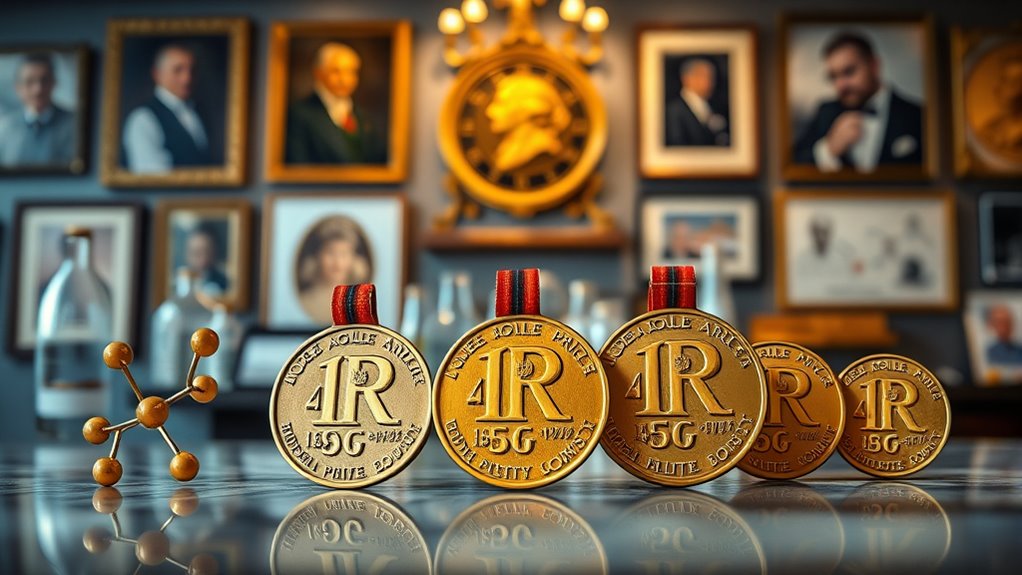
Have you ever wondered what sets some scientists apart in the world of chemistry? Double laureates are rare, but they leave lasting impacts. Frederick Sanger, the only scientist to win two chemistry Nobels (1958, 1980), revolutionized genetics with DNA sequencing and protein structure studies.
Barry Sharpless earned his two awards (2001, 2022) for “click chemistry” and bioorthogonal reactions, simplifying drug development. Marie Curie, the first woman to win two Nobels (1903 Physics, 1911 Chemistry), demonstrated radioactivity as an atomic property, laying foundations for nuclear medicine.
Linus Pauling received two unshared Nobel Prizes—Chemistry (1954) and Peace (1962)—for bond theories and anti-nuclear activism. These double laureates exemplify groundbreaking contributions that transformed our understanding of molecules, atomic properties, and societal issues.
Frequently Asked Questions
How Has the Geographic Distribution of Nobel Laureates Changed Over Time?
You see the geographic distribution of Nobel laureates shifting over time, from Europe’s dominance in the early 20th century to the US becoming the leading country after WWII. Many European-born scientists migrated to America, boosting its laureate count.
Today, the US hosts the majority of laureates, often immigrant researchers, while European countries like the UK and Switzerland also maintain strong international talent. Japan and Sweden remain more locally focused.
What Criteria Are Used to Select the Nobel Chemistry Laureate Each Year?
Imagine a jury carefully weighing each candidate’s groundbreaking work. You’ll find the selection criteria focus on scientific impact, innovation, and long-term influence.
Nominators, like expert judges, propose candidates, and the committee consults specialists to evaluate contributions. The process is thorough, involving screening, expert assessments, and consensus-building, ensuring only the most influential chemists, whose discoveries truly advance science, earn the prestigious Nobel Chemistry Prize each year.
How Does Team Collaboration Influence Nobel Prize Awards in Chemistry?
You see that team collaboration plays a vital role in Nobel chemistry awards. When you work with others, your chances of making groundbreaking discoveries increase.
Sustained collaborations lead to stronger, more innovative research, often resulting in recognition. The Nobel committee values interdisciplinary and team efforts, so you’ll find that successful laureates usually have stable, diverse partnerships that drive scientific breakthroughs and contribute greatly to their winning work.
What Role Does Emerging Technology Play in Recent Nobel Chemistry Discoveries?
Emerging technologies play a vital role in recent Nobel chemistry discoveries by enabling scientists like you to explore and manipulate chemical systems more efficiently. These innovations, such as AI-driven protein prediction and advanced measurement tools, accelerate research, open new frontiers, and often lead to groundbreaking breakthroughs.
How Does the Nobel Prize Impact Young Scientists and Early-Career Researchers?
You’re inspired by the Nobel Prize because it shows you what’s possible through innovation and dedication. It provides role models, boosting your confidence and guiding your research choices.
The prize highlights important fields, opening doors to collaboration, mentorship, and funding, helping you develop your skills.
Seeing laureates’ achievements motivates you to pursue impactful, groundbreaking work, knowing that your efforts can someday lead to global recognition and meaningful scientific advances.
Conclusion
You’ve seen how the Nobel Prize in Chemistry has shaped scientific history, highlighting groundbreaking discoveries and inspiring generations. It’s a tribute to humanity’s relentless pursuit of knowledge, pushing boundaries beyond what you thought possible. As future breakthroughs emerge, remember that this prestigious award will continue to celebrate the brightest minds transforming our world. The journey of discovery is unstoppable, and the Nobel Prize remains its shining beacon, guiding us toward a limitless future.
